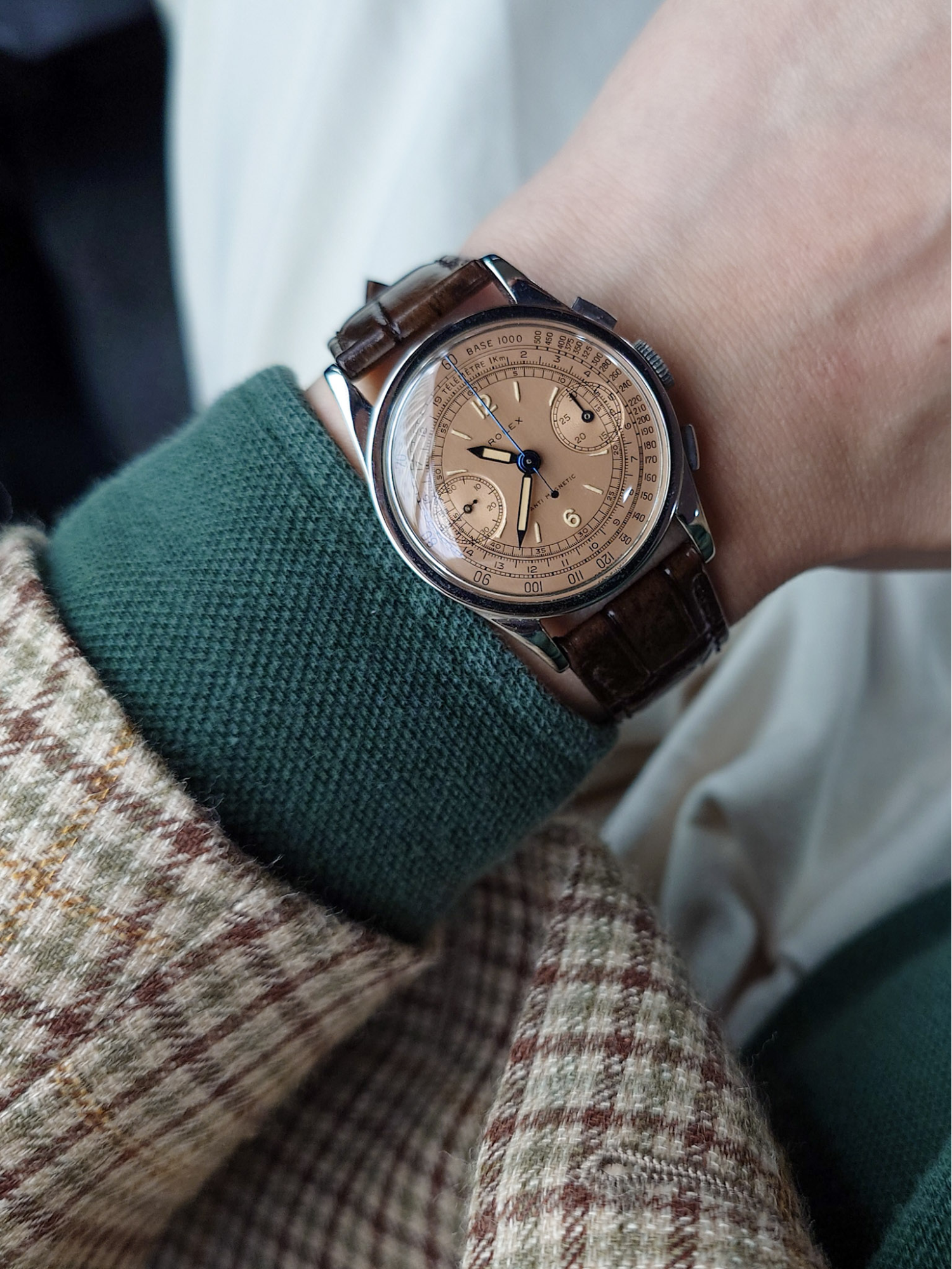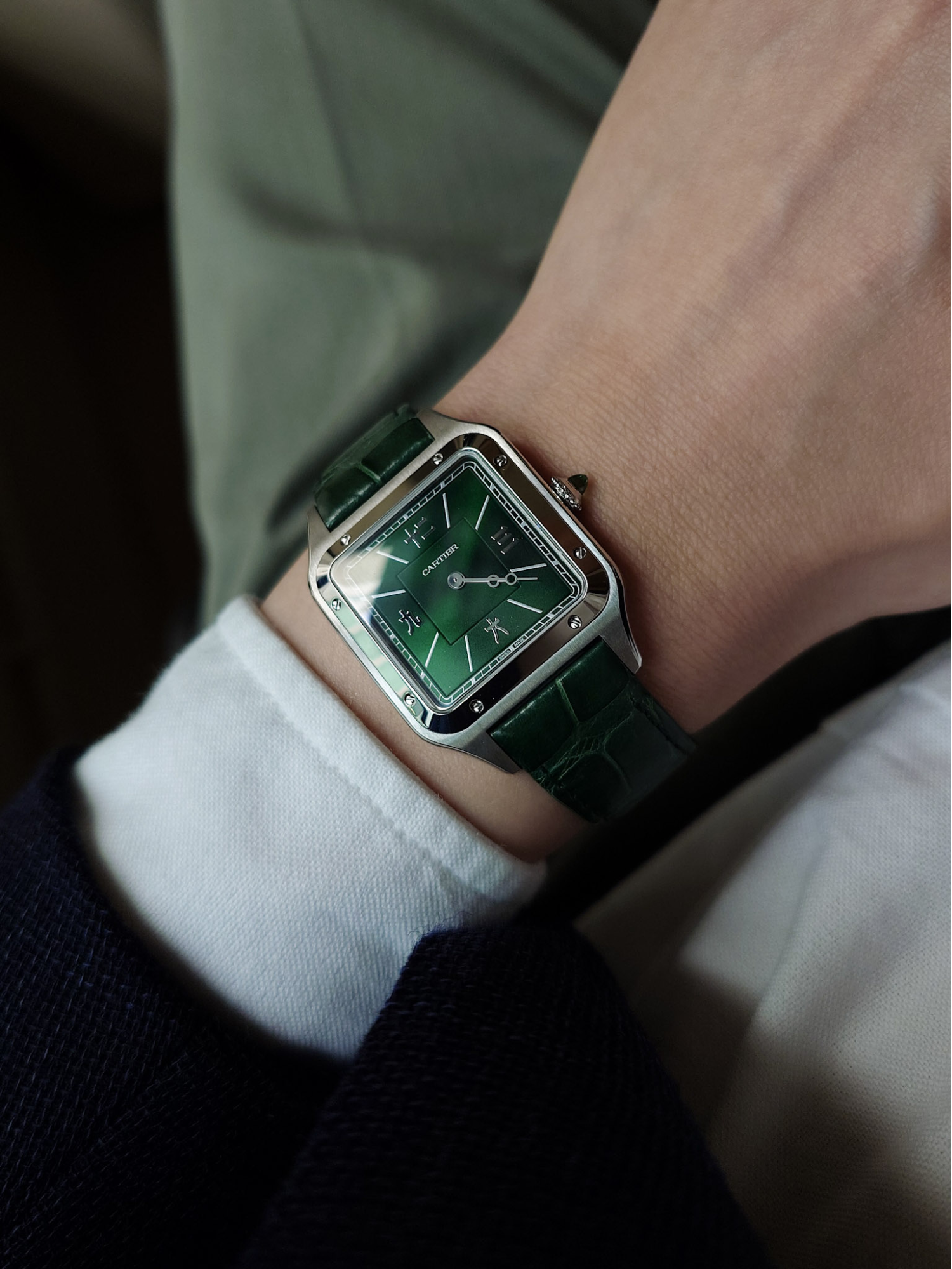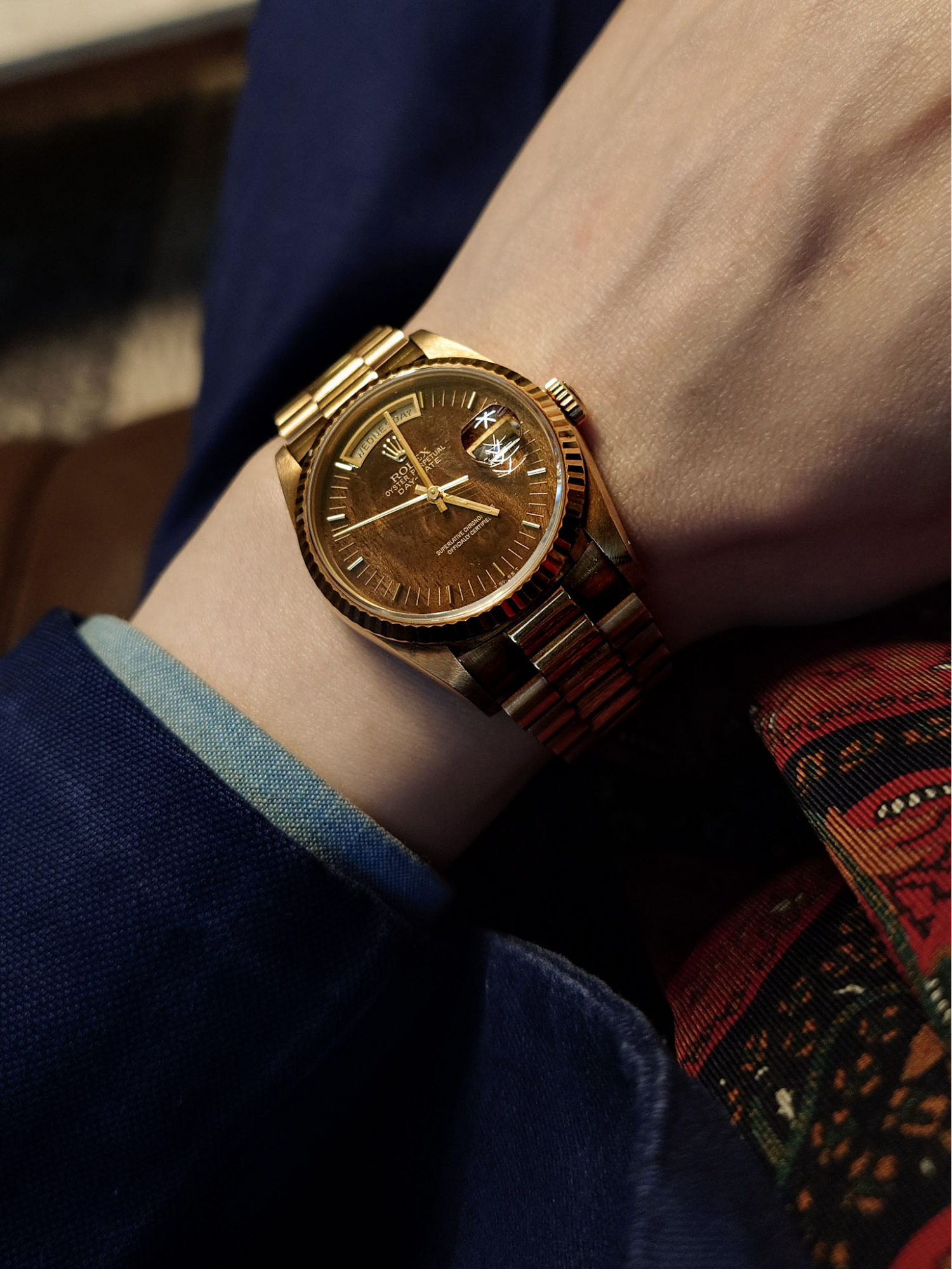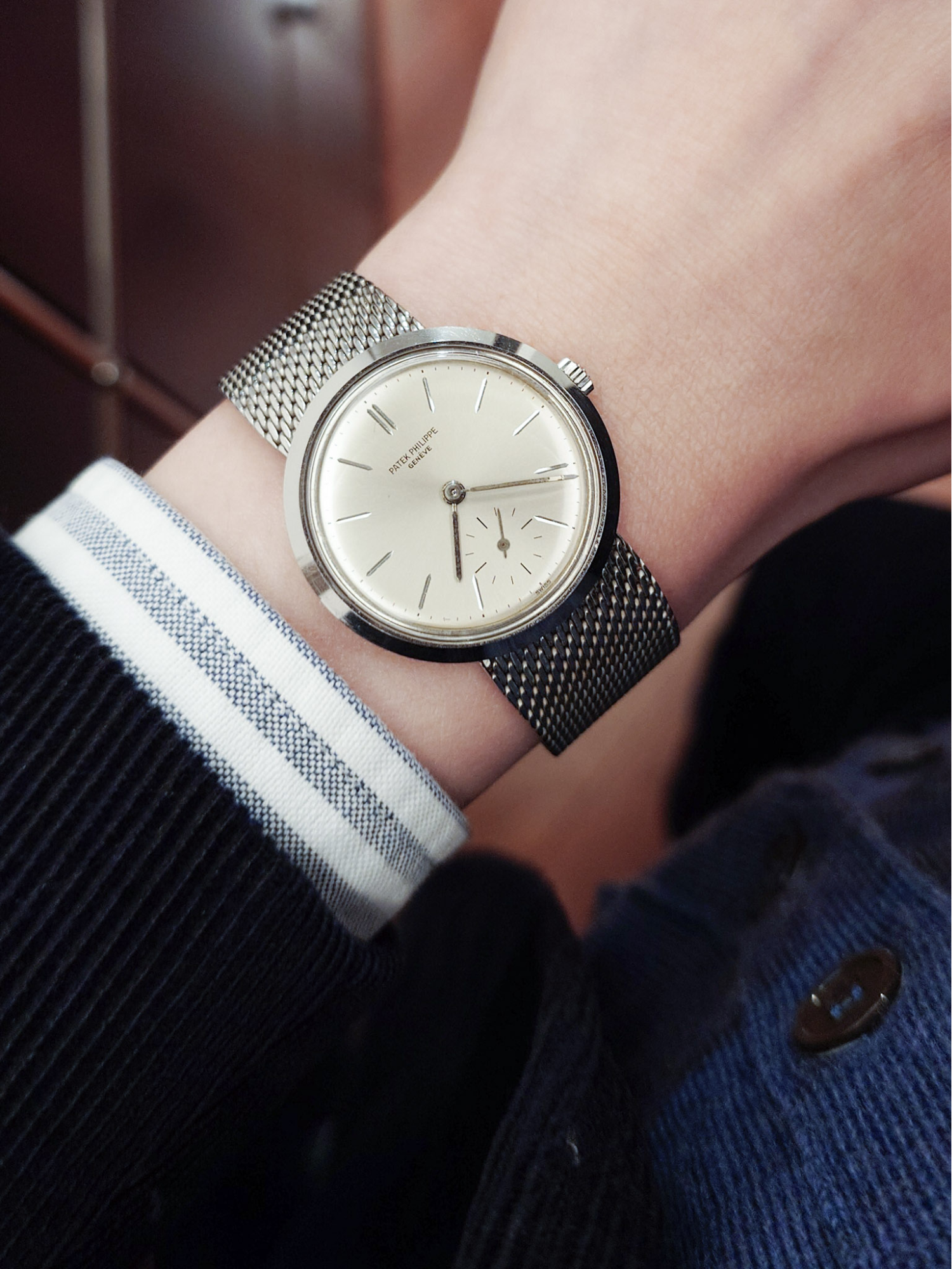Mark's 12 Principles of Watch Collecting
Rare watches are not always great, great watches are not always rare.
Unpopular watches may become popular but rare watches will always remain rare.
Expensive watches can be worth the cost. Cheap watches are not always worth the savings.
A perfect condition watch is priceless until you actually have to wear it.
See the watch as a whole, not just a collection of parts.
Make your judgements alone first and seek others' opinions later.
What you will wear the most is what fits you the best.
All your watches want your time but you only have one wrist.
Appreciation of a watch scales with time spent wearing it and understanding it.
Learn to buy and sell. Mistakes are your tuition. Knowledge gained outlasts any watch.
You can hold a watch forever but a watch cannot hold your attention forever.
All watches deserve a good home.
Christian Klings
Bespoke
Raymond Weil Millesime
Japan Edition
1.
Rare watches are not always great, great watches are not always rare.
A rare, scarce watch that impresses you in design and craftsmanship is a wonderful thing. I treasure these.
There are also watches that are just "rare". Their main quality is rarity. I usually ignore these.
Finally, there are watches that are excellent and you can purchase them any day of the week. I gladly buy these.
Patek 2555r
Credor Goldfeather
Limited Edition
2.
Unpopular watches may become popular but rare watches will always remain rare.
Popularity is function of people.
Something is popular if:
Lots of people know it and want it.
Something is unpopular if:
Lots of people don't know it.
The majority of people who do know it don't like it.
Why is it popular? Did the perfect storm of critical acclaim and limited availability occur? Did it cross the critical mass threshold where so many people want it that other people who were on the fence were sucked in? Are those who influence opinion trustworthy and relevant to your own views? Is it just that good that its success is well deserved?
Conversely, why is it unpopular? Was it too ahead of its time? Too behind its time? Too expensive? Too cheap? Too difficult to understand? Too obscure to be noticed? Too irrelevant to people's lives? Did the brand upset its customers and fans?
Why is it rare? Is it a groundbreaking aesthetic style? Does it feature an unusual complication? Is it because the watch is difficult to make? Is it related to a special period in time? Is it so old that many have disintegrated over time? Did the manufacturer produce very few? Was it a special order of some sort?
Most importantly ... do you like it? Do you feel something when you see it?
Unpopular may become popular but the reverse is also possible. Watches can fall out of favour. Pocket watches trade at a fraction of what they traded for just a few decades ago. Certain modern watches spiked in popularity these last few years then became dramatically less popular since.
There are also watches that are so rare and so obscure that they have little chance to be discovered at all. They may never become popular.
Does that matter?
The watches I enjoy searching for are those that are unpopular because they are difficult to understand. They have features that people overlooked or simply haven't started looking for yet. Watches with subtle details that need time to reveal themselves to you are often the most satisfying in the long term.
A great craftsman once told me: "It helps to have good eyes". Search patiently and look carefully.
Patek Philippe 3970g
FP Journe Resonance
Special Order
3.
Expensive watches can be worth the cost. Cheap watches are not always worth the savings.
Expensive and cheap are relative descriptions. First, you have to decide what value you personally attach to a watch before you can declare it either expensive or cheap.
What is the value of a watch to you? First and foremost, it's an abstraction of how much you like the watch. If you'd go so far as to say you love it, then theoretically there is almost no ceiling on price. Of course, in reality, there are a mixture of other factors at play.
The price of the watch on the primary (official retailer) and secondary (grey or pre-owned) markets will always loom large in any collectors' mind. The range of these prices act as anchors that keep your perception of value in their vicinity rather than free floating. An anchor is a reference point that creates a mental bias. People are much less likely to pay one million for something they know someone else only paid one hundred for. While this is reasonable behaviour, it is can also hamper bold decisions especially as you reach the less explored frontiers of collecting where price information is scarce. Thus, the question comes back to "how much do I love this watch?" - a judgment only you can make.
Other factors such as rarity, aesthetics, technical accomplishment, craftsmanship, condition, authenticity, liquidity and provenance all play into the value calculation but every person has their own unique sensitivity to each of these factors.
An interesting internal debate happens when you consider competing options. One might say "I want to buy watch X but for that money, I could buy the similar watch Y for 50% less instead". That suggests that person was not looking for X in the first place but rather for a certain set of features that Y shares. To put it another way: A diver's watch is substitutable for another diver's watch but a Submariner is not substitutable with a Seamaster.
It can be tempting to purchase a cheap watch, especially if it seems to carry a hefty discount on its known retail price. It's often easier to make a judgement based on a price rather than trying to understand if this is the watch for you. If your focus is on whether you want a particular watch or not, you will be immune to the siren song of "cheap".
Is it better to overpay or underpay for a watch? Of course nobody wants to pay more than they have to. However, it is worth remembering that if you are still willing to purchase the watch despite being at the limit of what you perceive the value of the watch to be, it is probably a good sign that the watch is important to you. Conversely, if you bought something that you would only buy at a heavy discount, it suggests that you really didn't like the watch much in the first place.
There is one important saving grace to "cheap" - the opportunity to experiment with relatively little risk. If you are trying to explore and expand your taste, it's helpful to know you can sell something that wasn't right for you without a significant loss. Also, as mentioned in Principle #1 - there are a lot of great cheap watches out there.
In my own personal experience, I have derived enjoyment and some financial success picking watches that I felt strongly about, even when they seemed overpriced to other people. Sometimes you simply see something special before others do. Also, even if nobody else ever appreciates the watch that you love, who cares? You own something you truly wanted and there is always contentment in that.
Patek Philippe 1526j
Restored by Patek
Rolex 2811
Restored by Rolex
4.
A perfect condition watch is priceless until you actually have to wear it.
Rarity is inextricably linked to condition and rarity has a price. Out of a thousand watches of the same reference that are 50 years old, how many might have survived in perfect condition? How much will you pay for that perfection? How much does it cost you each time you chip that perfection away?
How important is perfection? Some watches need to be in good condition to retain the designer's original intentions. Maybe their case shape needs to retain certain crisp angles and lines for the design to be considered intact. Other watches age gracefully with patina and wear. Sometimes, all you can afford is a mediocre example of a great reference. I'd rather have the chance to own and wear something than never own it at all.
Should you restore a watch? I've never shied away from a well done restoration. A chronograph movement that has lost its crisp click or a dial whose markings have seen too much decay deserve a second chance.
To be able to acquire something perfect is a worthy goal. It takes patience and resolve to track it down and add it to your collection. However, is there joy in maintaining perfection? Some see their role as keepers of relics but not me. The watches that brought me the most satisfaction are those that I wore and wore down in my own way. As they became less and less perfect, they became more and more mine.
Masa’s Pastime Sohkoku
Piece Unique white gold / shakudoh
Masa’s Pastimem Sohkoku
Back View
5.
See the watch as a whole, not just a collection of parts.
A curious aspect of owning a watch is you are never able to observe the entire watch in a single glance. When you wear it, the movement is hidden from you. When you turn it over and inspect the movement, the dial is no longer visible. Yet when you form your opinion on a watch, you try to consider all these things at once.
One of the most important yet intangible aspects of design is "balance", which you could also understand as "coherence". In theory, It means everything is in its right place and there is nothing to be added or taken away.
An unfortunate trend in products today is over-design. The root of this is our tendency to prioritize counting "features". X watch is considered desirable because it has this and that and the other feature. However, it does not take into account the overall balance of the design. Imagine if you had a four bedroom house with a swimming pool but the entire house was only 100 square feet?
Study a watch carefully, wear it and own it if you can before you pass judgement. When you are feeling pleased with a watch, think about why. Everyone has different priorities and its good to know where your affinities lie.
Louis Vuitton Tambour Convergence
Cartier Tank Louis Cartier
Mosiac Dial limited edition w/ bracelet by tri-gold bracelet by The Armoury
6.
Make your judgements alone first and seek others' opinions later.
There are two scenarios where this principle is especially important.
The first - One of the joys of collecting is finding a treasure before anyone else. The treasures are already out there. Many great watches are often overlooked, the challenge is separating the great from the good on your own. You are trying to find something no-one else has seen so there's really no-one to ask. Create conviction in your own judgement by developing your knowledge and experience.
The second - Auction pricing. In my opinion, the most rational way of dealing with an auction is to decide a price on your own prior to the event, submit it as an absentee bid and walk away. See how things turn out after the auction has ended. With this approach, you have restricted yourself to paying at most the price that you found acceptable and if you're lucky less than that. To watch and bid live is to subject yourself to the pricing opinions of others and potentially be influenced by them.
Making a judgement alone is daunting. Our judgment is so easily swayed. Sometimes the right photo, the right story, the right person wearing the watch is enough to change your opinion from a maybe into a yes. That is salesmanship and we are always being sold to.
We have a tendency to overweigh recent experiences. We are also prone to focus on negative more than positive experiences. Just breezing past some social media commentary could bias a snap judgement.
Slow down, take a moment to collect all your thoughts and form a thorough opinion that is for yourself and your own tastes.
Vacheron Constantin American 1921
36.5mm size
Audemars Piguet Royal Oak
34mm quartz
7.
What you will wear the most is what fits you the best.
I have switched from speaking about "you" to speaking about "I" because these next few principles are less general and more personal and I can see other people living their lives very differently.
I derive the greatest pleasure from my watches when I am wearing them. I derive the most pleasure from the watches I wear the most. So the question is - why am I wearing this watch? And as a follow up - why this watch instead of those watches? The answer is: "this watch that I wear fits me".
It is important that the watch fits me physically. I find the size enjoyable to wear, not clumsy or obtrusive. It feels not just comfortable but a part of my body. Quite simply, it is easy to wear this watch.
The watch fits me as a person. My overall appearance is how I interact with the rest of the world. People inevitably form their opinions about me based on my appearance and the watch will be factored into that. As a result, I need the watch to be inline with how I see myself as and how I want people to perceive me. It may sound abstract but having spent my career in the world of clothing, I strongly believe that people look their best when their clothes accurately represent who they want to be. Fundamentally, it is because they can be comfortable in their own skin and the world notices that.
Even the most beautiful watches will not get worn and enjoyed if they do not fit you physically or otherwise.
Cartier Tank Cintree NSO
Special Order Tank Cintree with matching platinum bracelet
Tudor Black Bay 54
Special Project for The Armoury
8.
All your watches want your time but you only have one wrist.
Some people can accumulate watches and build huge collections but not me. It makes me uncomfortable to have watches stored away. I feel guilty that they are not being seen and enjoyed. I feel burdened with the care of so many of them, making sure they are stored and serviced properly.
Berneron Mirage 34
Rolex 5504
9.
Appreciation of a watch scales with time spent wearing it and understanding it.
The most enjoyable watches are those that reward your attention by revealing something more the longer you wear them. Details that are not immediately apparent but become prominent with careful study are immensely satisfying and doubly so if you had to learn something new before you could appreciate what was already there.
The physical feeling of a watch is carefully considered by the people who designed and made it so learn to be sensitive to its sensations. Take a beginner's class on watchmaking and you will be surprised how all those parts have been cleverly conceived and carefully constructed. Experiment with photography of your watches. Even using your phone alone is fine. It will familiarize you with the nuances of shapes and textures of the watch, one of my favourite aspects of watches.
Cartier Santos Dumont
Limited Edition “Les Flaneurs” by Revolution Magazine
A Lange & Sohne Saxonia
10.
Learn to buy and sell. Mistakes are your tuition. Knowledge gained outlasts any watch.
Buying wisely, as mentioned in many of the principles above, is only half the equation. Selling requires you to understand the watch from new perspectives.
Firstly, you must understand why you are selling a particular watch. What was it that meant the watch did not meet your standards?
Secondly, you must understand the watch from the perspective of someone else. Interested buyers will come to you with questions that you may never have considered and it forces you to improve your knowledge.
As part of selling, teach yourself how to do your own watch photography. These days, cameras on phones are sufficient, you just need patience and good lighting, even a window on a sunny day will do. Creating your own watch photography trains your eyes.
It's inevitable to buy some duds along the way but don't let them turn into dead weight. Go through the process of selling and learn more about your own tastes as well as what you once owned.
Rolex Day Date
Patek 5110g
11.
You can hold a watch forever but a watch cannot hold your attention forever.
Nothing is forever. Just because a watch is expensive, doesn't mean you need to keep it forever. Don't be afraid to let your former grails go. Rather than letting something you once loved languish in a safe, it's far better to free up resources and put it towards something that excites you.
Make it stand out
Whatever it is, the way you tell your story online can make all the difference.
Make it stand out
Whatever it is, the way you tell your story online can make all the difference.
12.
All watches deserve a good home.
Every watch, be it good, bad, cheap, expensive, legendary, ordinary - was the result of someone's or many someone's efforts. Given the sheer volume of watches one sees these days, it's easy to underestimate how difficult it is to produce even a simple watch. Treat them with respect. Just because they are not to your tastes doesn't mean someone else might not love them.
There is sadness in parting with your watches but you can always share the next owner's joy.
Naoya Hida Type 1D-4 & -5
Naoya Hida x JN Shapiro x The Armoury
Type 1D-4 & -5 “East-West”
H. Moser Total Eclipse
Special Edition for The Armoury
Thanks for reading. If you have any comments, feel free to reach me using the form below or send me an IGDM @markchodotcom.
Mark (edit 2025/11/23)

























